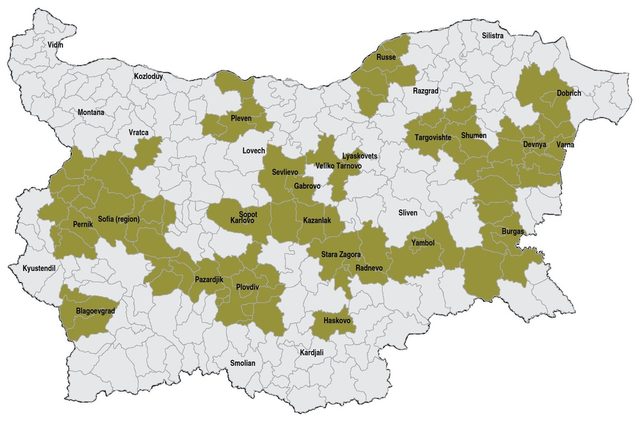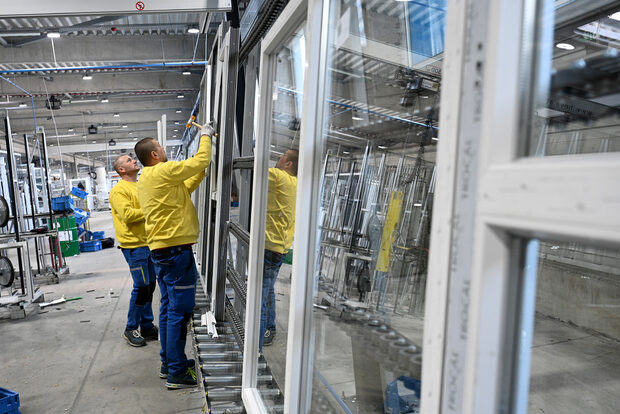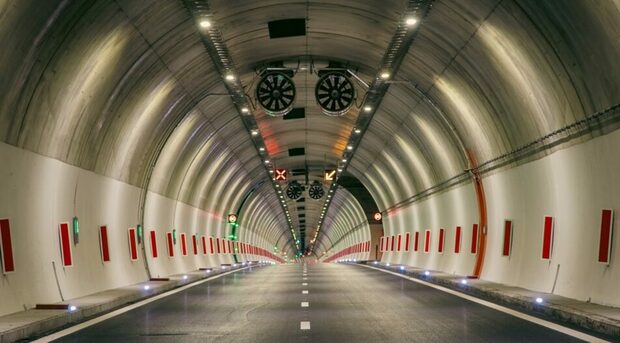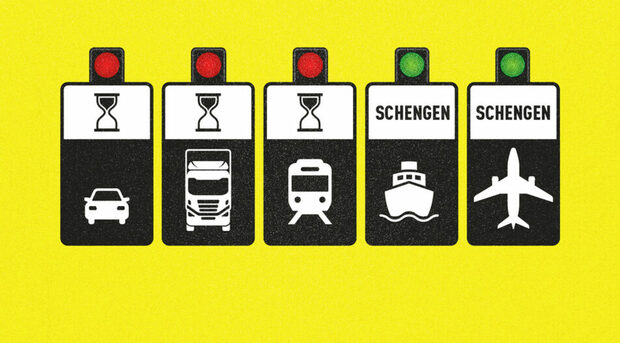• The former islands of economic activity in Southern Bulgaria have started to merge
The analysis of the economic activity in Bulgaria shows that in 2015 only 1/3 of the country's territory was covered by vibrant economic centers, but 86% of the national output was generated there, according to the latest data available. In other words, about two-thirds of the country was, figuratively speaking, an economic desert, with the exception of a few oases, where the remaining 14% of the country's output were generated.
Economic centers are formed around the so-called economic cores that attract significant daily labor migration from the neighboring municipalities (more than 10% of the employees travel on a daily basis and work in the cores), have a high concentration of employees and generate a relatively large output.
Three groups of economic centers are formed in Bulgaria:
• Large economic centers that have a very strong core and huge periphery such as Sofia and Plovdiv;
• Smaller centers that still have a periphery but it is often limited to the neighboring municipalities such as Ruse, Pleven and Shumen;
• Specific economic centers neighboring each other and having many points of contact, although they have a very limited or no periphery such as Gabrovo-Sevlievo, Stara Zagora, Kazanlak and Radnevo.
What is particularly interesting is that the process of concentration of economic activity in the centers has continued over the recent years. In 2011, 85% of the production of the country was generated in the economic centers, i.e. within five years this share has increased by 1 percentage point (pp). The continued attraction of capital and people there resulting from the existence of appropriate infrastructure, market size, synergies with existing businesses, social environment and other factors, is likely to fuel this trend of concentration of the country's economy.
The economic centers are also the ones that attract the largest share of investment - 81% of total foreign direct investment (FDI) in the country targeted them as at the end of 2015. The situation with the other main indicator of investments - the annual costs for fixed tangible assets (FTA), is similar - 3/4 of all annual FTA costs (2015) were also incurred in the centers.
These centers employed 3/4 of the people employed in the economy in 2015. At the same time, in 2016 62% of the country's population lived in the centers, which means that over 1/3 of the people in Bulgaria live outside the economically most active and promising territories of the country. Interestingly, in addition to greater output, the economic centers concentrate more and more population as a relative share of the total population of the country - in 2000 59% of the population lived there, and in 2016 this share was already 3 percentage points higher.
The total number of economic centers in the country is 20. Their size, territorial scope and sectoral profile are extremely varied.

It does not come as a surprise that the largest economic center is formed around Sofia Municipality. It is the largest in terms of territory, population, output, investment and number of employed people. Sofia Municipality is also distinguished by the presence of a secondary core, namely the municipality of Pernik. This is due to the fact that the municipality of Pernik simultaneously attracts labor migrants from the surrounding municipalities and is itself a source of daily migration to Sofia Municipality at a significant level - Pernik is the municipality with the highest negative net labor migration in the country. The center of Sofia Municipality generated 43% of the total output in 2015, while in 2011 the center accounted for 42% of production at the national level. The center around Sofia Municipality encompasses 18 municipalities, employs about 1/3 of the people employed in the economy and attracts 55% of all FDI in Bulgaria, according to end-2015 data.
Unemployment in Sofia Municipality is the lowest (3.5% in 2016) and wages are the second highest (1174 BGN average gross monthly salary in 2015) after the relatively small Kozloduy Center, where the high salaries paid in the nuclear power plant located there have a significant weight in the average wages. In addition, university graduates in the Sofia Center account for the largest share of the local population - about 1/3 compared to an average of 20% for the country. The quality of education, measured by the results of the Bulgarian Language and Literature matriculation examinations, is also the highest in "Sofia" - 4.48 in 2016 (compared to 4.17 for the country).
The other relatively large centers in the country are formed around the cores of the municipalities of Plovdiv, Burgas and Varna. However, even the second most productive center, "Plovdiv", lags far behind "Sofia" with output equal to around 1/5 of the production generated by the largest economic center. The total output of the three centers ("Plovdiv", "Burgas" and "Varna") and the number of employees there are slightly more than half of those of the broad economic center around Sofia, and foreign investments (cumulative) stand at around 1/3.
The center around Plovdiv, which is the second largest in the country, comprises 12 municipalities and generates about 1/10 of the country's production. Thanks to the significant investment and attraction of human capital from more distant municipalities, in 2015 Plovdiv marked 39% production growth compared to 2011. This is the second highest growth rate for the period, following the 40% increase in the much smaller center around Ruse.
Interestingly, south of the Balkan mountain range there is a "warm connection" between all centers, they flow into each other. At the same time, in Northern Bulgaria, economic centers are rather islands of high economic and investment activity, surrounded by large areas of low activity and weak economy. The only exception is the "agglomerate" of several centers in Northeastern Bulgaria, which are connected to each other - Varna, Shumen and Targovishte, comprising a total of 17 municipalities, 10 of which fall within the economic center around Varna. Perhaps the lack of a highway north of the Balkan range also contributes to this situation.
The smooth transition from center to center in Southern Bulgaria suggests that in a few years the boundaries between some of them may no longer exist. For example, the "Sofia" center is merged to the east into the "Pazardzhik" center, which in turn merges into the "Plovdiv" center. The Haskovo center is not far from the "Plovdiv" center and it has a relatively fast growing core, but currently lacks any periphery. "Haskovo" is now officially positioned as part of the Trakia Economic Zone (TEZ), which was formed over the last year around Plovdiv and unites six industrial zones. This development, of course, is highly influenced by the completion of the construction of two highways in Southern Bulgaria over the recent years - Trakia (connecting Sofia and Burgas) and Maritsa (connecting Trakia highway at Orizovo junction with the border with Turkey at Kapitan Andreevo border checkpoint.
The aforementioned agglomeration of centers in Southwestern and South-Central Bulgaria is also expanding eastwards. In the spring of 2017, it was reported that TEZ will be extending to Burgas.
Four economic centers are formed in the region around Stara Zagora - Sopot, Kazanlak, Stara Zagora and Radnevo. We may also add Galabovo, where the data from the last several years indicate the emergence of a new center, which, however, has not yet expanded. These five centers, given their territorial proximity, infrastructure and economic connections, are part of a wider economic center with a predominantly industrial profile around Stara Zagora. The local authorities of Stara Zagora have already started work on the formation and positioning of the Zagore Industrial Zone. Undoubtedly, this step has been provoked by the positive development of Plovdiv, which is to a large extent the result of the positioning of TEZ as a leading investment destination in Bulgaria. The Zagore zone will be the first attempt to replicate the successful model of TEZ. The socio-economic profile of Stara Zagora requires it to be differentiated as a separate investment destination and not simply to attach it to TEZ. This area has an untapped development potential in the field of information technology and outsourcing led by the example of Plovdiv, which is important for retaining the highly qualified young people in the area.
The lack of good and fast transport infrastructural links between Northern and Southern Bulgaria is another factor influencing the boundaries of the economic centers in the country. For example, there are several economic centers in Central Bulgaria on both sides of the Balkan range - the centers around Stara Zagora to the south and the economic centers of Gabrovo-Sevlievo and Veliko Tarnovo to the north. The absence of adequate infrastructural connection across the mountain hinders the contacts between the economically active territories on both sides of the mountain and limits their growth potential.
The Gabrovo-Sevlievo Economic Center to the north of the Balkan mountain range also represents an interesting formation. It consists of two cores - the municipalities of Gabrovo and Sevlievo - which are united because of their geographical proximity and the relatively high labor migration between them. The center has no periphery and its profile is industrial. The center around Veliko Tarnovo is among the relatively smaller formations, consisting of a core municipality - Veliko Tarnovo, and a periphery, which is represented by a single municipality - Lyaskovets.
Besides these two centers a further four centers are formed to the north of the Balkan range, which have a relatively narrow scope: the centers around the cores Ruse, Pleven, Kozloduy and Dobrich. The center around Dobrich includes Dobrich Municipality, which surrounds the city on all sides, while the boundaries between the two are simply administrative rather than economic. By the way, the situation is relatively similar in the smallish municipality of Yambol and its surrounding Tundzha Municipality, which is part of the Yambol Economic Center, as well as the municipality of Sopot and the surrounding municipality of Karlovo, the latter being a natural periphery of Sopot.
Among the economic centers in Northern Bulgaria, Ruse stands out as the largest producer, having a share of about 3% of the total output of the country. It ranks second in Northern Bulgaria after the center around Varna and 5th in the country. The center around Ruse comprises 5 municipalities and employs about 3% of the people employed in the economy (2015).
The analysis of the economic centers in the country clearly shows that the successful investment destinations are not administratively limited. The cores of economic growth in the country are increasingly relying on the surrounding territories to maintain their growth.
• The former islands of economic activity in Southern Bulgaria have started to merge












